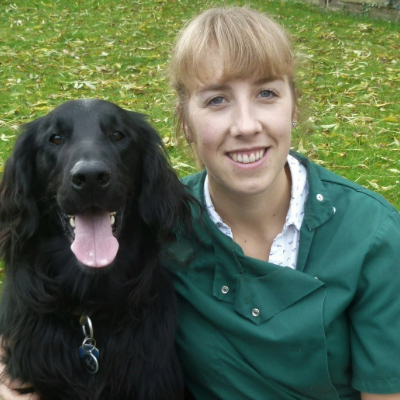How to get my dog to stop whining
How to get my dog to stop whining is at the top of many a pet parent's priority list — this vet's advice is a great starting place.

How to get my dog to stop whining is a question asked by many a frustrated pet parent — and it's not hard to understand why! Much like the sound of a baby crying, a whining dog can send your stress levels soaring.
While it may seem that your dog is whining for no apparent reason, whining is your pup's way of trying to communicate to you that something isn't right. They may be feeling anxious or in pain, or perhaps the whining is being triggered by excitement or a desire for your attention.
If you're anything like us, you may find it tempting to dish out a long lasting dog chew or a few toys to try to appease your canine companion and keep them calm, but unfortunately, these are only temporary solutions. If your dog is whining excessively, getting to the root cause is key for helping you devise a strategy that will slowly help your dog overcome this behavior.
To help you do just that, we consulted expert vet Dr. Rebecca MacMillan to get her professional thoughts on why dogs whine, some simple steps you can take to stop your dog from whining, and why sometimes silence is the answer.

Dr. Rebecca MacMillan is a companion animal vet with over 13 years of experience treating and looking after pets. She graduated from the UK Royal Veterinary college in 2009, and has worked in several practices over the years. Rebecca is also an experienced writer, using her veterinary background to offer expert opinion and advice.
Why do dogs whine?
There are few noises in the world more difficult to deal with than the sound of a dog whining. You may find yourself torn between feeling a great deal of worry and compassion for your canine companion, while also feeling irritated and wishing it would stop.
If so, know that you're not alone. Whining can be a challenging issue to deal with and before you get to solutions, it's important to first understand what might be causing your dog to whine in the first place.
"Dogs whine for a whole array of reasons, so it’s important to look at the scenario they are in to help give you some clues," says MacMillan. "For example, they can whine when they are bored or feeling anxious."
Get the best advice, tips and top tech for your beloved Pets
Separation anxiety in dogs is an issue that can give rise to whining. "Dogs with separation anxiety are particularly prone to being extra vocal and whining when left on their own," confirms MacMillan, who goes on to say that "Whining may also occur because they are trying to get your attention, e.g. they need to go out to the toilet or want a reaction from you."
It's worth noting that pain or ill health can also be a trigger for whining. If you're at all concerned that may be the cause, check out these 10 signs your dog is in pain to see if they may be also showing other symptoms alongside the whining.
And it turns out whining isn't always something to worry about. "Dogs will also whine when they are happy and excited about something, like going out for a walk or interacting with other dogs!" says MacMillan.
How to stop your dog from whining

There are so many reasons why your dog may whine, which means putting helpful strategies in place to prevent or decrease the whining may take some time. However, once you've figured out what's driving this behavior in the first place, you can start to make some real progress.
Here are some simple steps MacMillan recommends taking to help put a stop to your dog's whining...
1. Get them checked over by a vet
If your dog is whining excessively, a trip to the vet can be a useful starting place. Your vet will be able to give your pup a thorough check-up and make sure nothing is going on physically that could be causing your dog to whine.
"Whining is a way for your dog to communicate so it is important to try and understand what they might be telling you. If you can’t immediately work out a specific need (e.g. they need to be let out to the bathroom or they are anxious about something), then it is important to rule out a medical problem next," explains MacMillan. "This is particularly important if your dog doesn’t usually whine or if they seem unwell generally."
2. Offer plenty of mental and physical stimulation
If your vet is happy that your dog is in good shape physically, the next thing that's well worth trying is adding more enrichment into their day.
"A dog that has plenty of exercise and works their brain regularly through training and play, is more likely to be content and settled," explains MacMillan.
The good news is, it doesn't just have to be a standard walk around the block or a game using one of the best dog toys, there are lots of ways you can mix things up to give your dog (and yourself!) plenty of variety.
Sniffing is a great example of an activity that will tire your dog out both mentally and physically. Scentwork uses a large part of your dog's brain and is both calming and tiring, both of which will help to bring your dog's arousal level down and help them relax. 'I tried a 45-minute 'sniffari', and it tired out my border collie more than a two-hour hike!' is an article well worth checking out if you'd like to learn more about the benefits of sniffing.
If you and your pup are a fan of traditional walking and tend to use that as a way to exercise, there are so many clever ways to have more fun with your dog on walks, so don't be afraid to experiment when it comes to weaving new forms of stimulation into your daily stroll.
We also highly recommend snuffle mats and other food puzzle toys if you're wanting to give your dog's brain a good old workout.
3. Reward positive behavior
If your dog is whining as a way to get your attention (as opposed to being in pain), it's really important that you avoid rewarding the whining by giving them what they want. That goes for both positive and negative reinforcement.
What do we mean by this? Well, with whining it can be easy to think that if we pet or cuddle our dog this will relax and reassure them and prevent the whining from continuing. But this is not the case. While it's normal to want to soothe your pup, positive attention will only teach them that whining is what captures your focus.
The same is true of negative reinforcement. If we speak harshly to our dogs or use other aversive actions (such as squirt bottles or physical punishment) one of two things can happen. The whining may continue (because even though the attention is negative, it's still attention) or the whining may cease out of fear but the root cause will still be there.
Instead, the science behind positive reinforcement for dogs suggests that we focus on rewarding the behaviors we do want to see and ignoring the ones we don't. "You should only give your dog treats and praise them when they are calm, to reinforce positive behaviors," confirms MacMillan.
So, when your dog is sitting quietly, that's the time to heap on the praise and dish out one or two of the best dog treats. This will help your dog learn that being quiet and calm is what gets them your attention, not whining.
Should you ignore a whining dog
If you've ruled out any medical issues that could be causing your dog to whine and you've met all their needs to the best of your ability, remaining quiet when your dog whines is the most appropriate strategy to adopt — even if it's also the hardest!
"Ignoring your dog is the most appropriate thing to do, praising your pet when they are quiet and settled," confirms MacMillan, although thankfully, she also adds that you don't need to go at it alone.
"For some dogs, even though all their needs have seemingly been met they may still whine. This could be due to behavioral issues, or because they are attention-seeking and trying to provoke a response from you. In these cases, it is a good idea to work alongside a qualified behaviorist to help improve things."
Whether you choose to go at it alone or seek out the support of a qualified professional, the most important thing is to avoid punishing your dog for whining, as this could make things worse.
We understand how difficult it can be to live with dog that's whining excessively, but please take heart — with time, patience and consistency, this issue can be overcome.
If you feel you and your pup would benefit from some help in resolving this issue, we highly recommend working with a professional. Our guide to how to spot dog trainer red flags is a great resource if you want to know what to be on the lookout for when hiring a trainer or behaviorist.

Kathryn is a freelance writer who has been a member of the PetsRadar family since it launched in 2020. Highly experienced in her field, she's driven by a desire to provide pet parents with accurate, timely, and informative content that enables them to provide their fur friends with everything they need to thrive.
Kathryn works closely with vets and trainers to ensure all articles offer the most up-to-date information across a range of pet-related fields, from insights into health and behavior issues to tips on products and training.
When she’s not busy crafting the perfect sentence for her features, buying guides and news pieces, she can be found hanging out with her family (which includes one super sassy cat and a kitten), drinking copious amounts of Jasmine tea and reading all the books.
She has written for a range of publications, including Fit&Well, Top Ten Reviews, LiveScience, Goodto, and Product Hunt.
